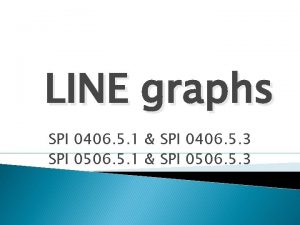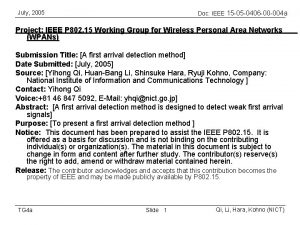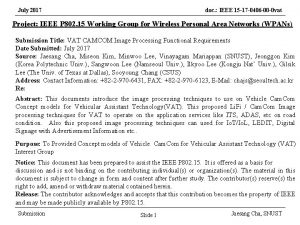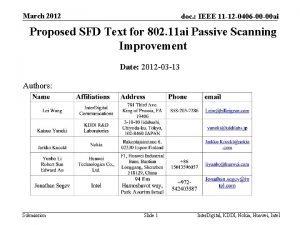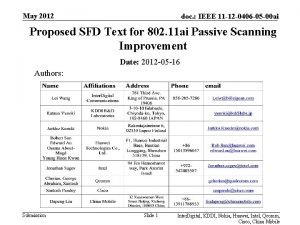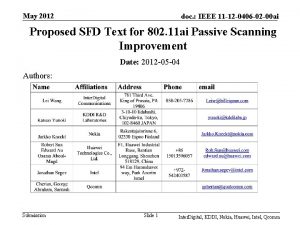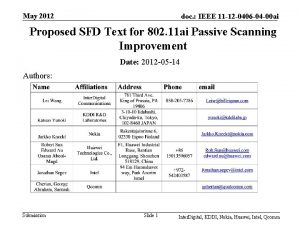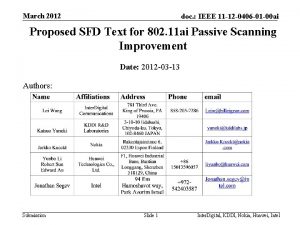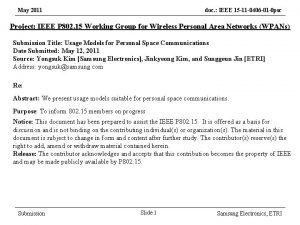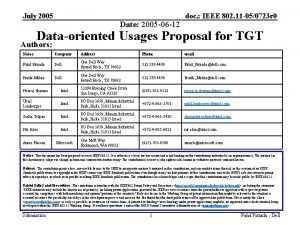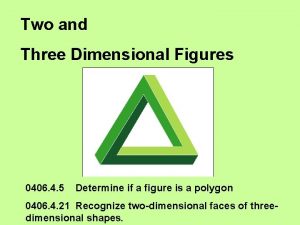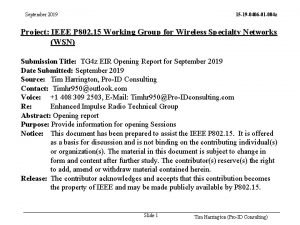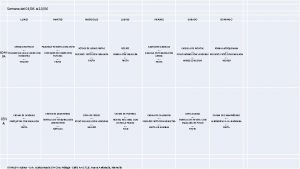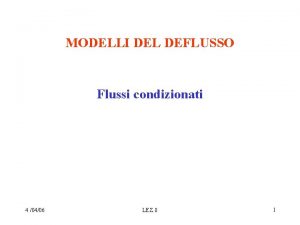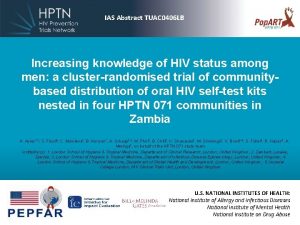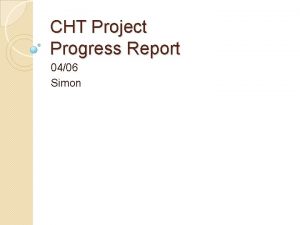July 2005 Doc IEEE 15 05 0406 00


























- Slides: 26

July, 2005 Doc: IEEE 15 -05 -0406 -00 -004 a Project: IEEE P 802. 15 Working Group for Wireless Personal Area Networks (WPANs) Submission Title: [A first arrival detection method] Date Submitted: [July, 2005] Source: [Yihong Qi, Huan-Bang Li, Shinsuke Hara, Ryuji Kohno, Company: National Institute of Information and Communications Technology ] Contact: Yihong Qi Voice: +81 46 847 5092, E-Mail: yhqi@nict. go. jp] Abstract: [A first arrival detection method is designed to detect weak first arrival signals] Purpose: [To present a first arrival detection method ] Notice: This document has been prepared to assist the IEEE P 802. 15. It is offered as a basis for discussion and is not binding on the contributing individual(s) or organization(s). The material in this document is subject to change in form and content after further study. The contributor(s) reserve(s) the right to add, amend or withdraw material contained herein. Release: The contributor acknowledges and accepts that this contribution becomes the property of IEEE and may be made publicly available by P 802. 15. TG 4 a Slide 1 Qi, Li, Hara, Kohno (NICT)

July, 2005 Doc: IEEE 15 -05 -0406 -00 -004 a A First-arrival Detection Approach Yihong Qi Huan-Bang Li, Shinsuke Hara and Ryuji Kohno National Institute of Information and Communications Technology (NICT) TG 4 a Slide 2 Qi, Li, Hara, Kohno (NICT)

July, 2005 Doc: IEEE 15 -05 -0406 -00 -004 a Outline • A system model • Delay estimation for a single-path propagation • A first arrival detection method for a multipath environment • Simulation results • Conclusion TG 4 a Slide 3 Qi, Li, Hara, Kohno (NICT)

July, 2005 Doc: IEEE 15 -05 -0406 -00 -004 a A system model Correlator A/D Delay estimation/ First-arrival detection A delay estimate A transmit signal TG 4 a Slide 4 Qi, Li, Hara, Kohno (NICT)

July, 2005 Doc: IEEE 15 -05 -0406 -00 -004 a A Delay Estimation Algorithm TG 4 a Slide 5 Qi, Li, Hara, Kohno (NICT)

July, 2005 Doc: IEEE 15 -05 -0406 -00 -004 a What is the problem? h(tn) correlation function h(tm+1) h(tm+Z-1) h(tm) tm+1 tm+2 tm+Z tn Given samples of a correlation function, how to estimate the time instant corresponding to the peak? TG 4 a Slide 6 Qi, Li, Hara, Kohno (NICT)

July, 2005 Doc: IEEE 15 -05 -0406 -00 -004 a What is information we know? correlation function autocorrelation tm+1 tm+2 tm+Z tn correlation = autocorrelation of s(t) +noise The expression is known. TG 4 a Slide 7 Statistics is known. Qi, Li, Hara, Kohno (NICT)

July, 2005 Doc: IEEE 15 -05 -0406 -00 -004 a How to use the information? Formulate a maximum likelihood estimation. However, it is complicated: • One dimension iterative searching • Nonlinear autocorrelation function • Lots of samples (N) involved TG 4 a Slide 8 Qi, Li, Hara, Kohno (NICT)

July, 2005 Doc: IEEE 15 -05 -0406 -00 -004 a How to simplify? Intuition: h(tn) samples near the peak are more important. h(tm+1) h(tm+Z-1) h(tm) • Use less samples tm+1 tm+2 TG 4 a tm+Z Slide 9 tn • Taylor expansion of autocorrelation function around the peak Qi, Li, Hara, Kohno (NICT)

July, 2005 Doc: IEEE 15 -05 -0406 -00 -004 a A simple solution where TG 4 a Slide 10 Qi, Li, Hara, Kohno (NICT)

July, 2005 Doc: IEEE 15 -05 -0406 -00 -004 a A simple solution • An algebraic solution, no iterative search • Less than 4 samples in general • No nonlinear function any more • Independent of noise level • Optimal in the sense that the estimate is approaching to theoretical lower limit as over-sampling is sufficiently large. TG 4 a Slide 11 Qi, Li, Hara, Kohno (NICT)

July, 2005 Doc: IEEE 15 -05 -0406 -00 -004 a A First-arrival Detection Method TG 4 a Slide 12 Qi, Li, Hara, Kohno (NICT)

July, 2005 Doc: IEEE 15 -05 -0406 -00 -004 a Why the problem is difficult? The estimation performance would be degraded considerably when the energy of the first arriving component is not dominant among multipath components of a received signal. TG 4 a Slide 13 Qi, Li, Hara, Kohno (NICT)

July, 2005 Doc: IEEE 15 -05 -0406 -00 -004 a Our Approach • A similar idea to the solution of nearfar problem in multiuser detection. • An iterative scheme: In each iteration, the present strongest signal component is estimated, and is removed from sample data to be processed in the next iteration. TG 4 a Slide 14 Qi, Li, Hara, Kohno (NICT)

July, 2005 Doc: IEEE 15 -05 -0406 -00 -004 a A graphic illustration h(t) i=2 There are three multipath components, and the second path is strongest. h(tn) i=3 i=1 h(t 2) h(t 1) t 1 TG 4 a t 2 tn t Slide 15 Qi, Li, Hara, Kohno (NICT)

July, 2005 Doc: IEEE 15 -05 -0406 -00 -004 a A graphic illustration (cont’d) h(ti 1+2) h(ti 1+1) In the first iteration, n=1, we estimate the time delay and amplitude the strongest multipath. Using less samples is better to avoid the interference from other multipath components. t TG 4 a Slide 16 Qi, Li, Hara, Kohno (NICT)

July, 2005 Doc: IEEE 15 -05 -0406 -00 -004 a Delay and Amplitude Estimation • Delay estimation can use the previous proposed method – Using less samples • Amplitude estimation, the ML estimation based on the delay estimate, known autocorrelation function and correlation samples. TG 4 a Slide 17 Qi, Li, Hara, Kohno (NICT)

July, 2005 Doc: IEEE 15 -05 -0406 -00 -004 a A graphic illustration (cont’d) h(t) The strongest multipath is removed by using the delay estimate, amplitude estimate and the autocorrelation function. Removed t TG 4 a Slide 18 Qi, Li, Hara, Kohno (NICT)

July, 2005 Doc: IEEE 15 -05 -0406 -00 -004 a A graphic illustration (cont’d) h(t) Since we are only interested on first arrival delay, samples with time instants later than the delay estimated just obtained is removed. n=1 Removed t TG 4 a Slide 19 Qi, Li, Hara, Kohno (NICT)

July, 2005 Doc: IEEE 15 -05 -0406 -00 -004 a Advantages • Robust to interference from other strong multipath components • Low computational complexity. – let the first arrival component be the M-th strongest component, the complexity is proportional to M. TG 4 a Slide 20 Qi, Li, Hara, Kohno (NICT)

July, 2005 Doc: IEEE 15 -05 -0406 -00 -004 a Simulation Results TG 4 a Slide 21 Qi, Li, Hara, Kohno (NICT)

July, 2005 Doc: IEEE 15 -05 -0406 -00 -004 a Notation • The conventional method: directly select the time instant corresponding to the largest sample. • Theoretical limit: assume a continuous correlation function is used. • Over-sampling ratio = sampling frequency/effective bandwidth. – E. g. , A Gaussian waveform N(0, a^2) has the effective bandwidth 1/2 a, a=1 ns, effective bandwidth 500 MHz. TG 4 a Slide 22 Qi, Li, Hara, Kohno (NICT)

July, 2005 Doc: IEEE 15 -05 -0406 -00 -004 a Example 1: sampling frequency=420 M TG 4 a Slide 23 Qi, Li, Hara, Kohno (NICT)

July, 2005 Doc: IEEE 15 -05 -0406 -00 -004 a Example 2: sampling frequency=625 M TG 4 a Slide 24 Qi, Li, Hara, Kohno (NICT)

July, 2005 Doc: IEEE 15 -05 -0406 -00 -004 a Example 3: sampling frequency=1. 25 G TG 4 a Slide 25 Qi, Li, Hara, Kohno (NICT)

July, 2005 Doc: IEEE 15 -05 -0406 -00 -004 a Concluding Remarks • A delay estimation method for mitigating the error due to digital sampling • A first arrival detection algorithm which is robust to weak first arriving signals TG 4 a Slide 26 Qi, Li, Hara, Kohno (NICT)
 July 14 1789
July 14 1789 Sources nso frenchhowell neill mit technology...
Sources nso frenchhowell neill mit technology... July 26 1953
July 26 1953 June too soon july stand by
June too soon july stand by Oscar and alphonse harris burdick
Oscar and alphonse harris burdick Poppies in july
Poppies in july Sensory language definition
Sensory language definition 2001 july 15
2001 july 15 Monday 13th july
Monday 13th july July 16 1776
July 16 1776 Malaga in july
Malaga in july May 1775
May 1775 July 1-4 1863
July 1-4 1863 July 2 1937 amelia earhart
July 2 1937 amelia earhart Gdje se rodio nikola tesla
Gdje se rodio nikola tesla Catawba indian nation bingo
Catawba indian nation bingo 2003 july 17
2003 july 17 On july 18 2001 a train carrying hazardous chemicals
On july 18 2001 a train carrying hazardous chemicals Poppies in july aoifes notes
Poppies in july aoifes notes Leaf yeast experiment
Leaf yeast experiment Tender mean
Tender mean June 22 to july 22
June 22 to july 22 July 1969
July 1969 Ctdssmap payment schedule july 2021
Ctdssmap payment schedule july 2021 April may june july
April may june july July 30 2009 nasa
July 30 2009 nasa July 4 sermon
July 4 sermon



























